In this article we are summarizing the flagship species examples.
Flagship is used as an icon for the representation of conservation movement. The concept of flagship species became known in 1980s.The focus is to prioritize certain animal species that are unique in an area and on the edge of becoming extinct.
Examples of flagship species include:
- Bengal Tiger (Panthera tigris)
- The Giant Panda (Ailuropoda melanoleuca)
- Golden lion tamarin (Leontopithecus rosalia)
- African elephant (Loxodonta)
- Asian elephant (Elephas maximus)
- Pemba flying fox
- Chesapeake blue crab
- Mountain gorillas (Gorilla beringei)
- Bonobo (Pan paniscus)
- Chimpanzee (Pan troglodytes)
- White rhinoceros (Ceratotherium simum)
- Black rhinoceros (Diceros bicornis)
- Polar bear (Ursus maritimus)
- Sea turtles (Chelonioidea)
- Manatees
- Bald eagle (Haliaeetus leucocephalus)
- European Otter (Lutra lutra)
- Monkey puzzle tree (Araucaria Araucana)
- Bornean Ironwood (Eusideroxylon zwageri)
- Malagasy Baobabs (Adansonia)
Flagship species has been categorized into three different groups:
- International flagship Species: This is a group of globally recognized species. Species include; Bengal tiger found in India but is globally known.
- Cultural flagship species: This represents a specific culture or a group of people, for example, Bornean ironwood that symbolizes Dayak people. Tribal people use this plant for their rituals and medicinal purposes.
- Ecological flagship species: This group represents species with unique diversity that includes Snow leopard which is an ecological and cultural flagship of Tibetan plateau.
Bengal Tiger (Panthera tigris):
They are found in India and sometimes called Indian tigers. It belongs to Panthera tigris tigris subspecies. Their population is declining at a fast rate and has been added into endangered species by IUCN.
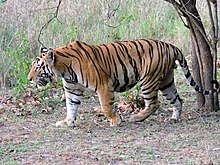
The Giant Panda (Ailuropoda melanoleuca):
They belong to the genus Ailuropoda and the species name is Ailuropoda melanoleuca. They are also known as panda bear and found in China. They are the rarest and most threatened animals in the world.
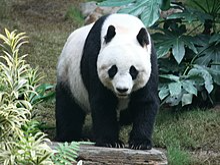
Golden lion tamarin (Leontopithecus rosalia):
It is also called golden marmoset belongs to the genus Leontopithecus. They are small and found in Brazil.
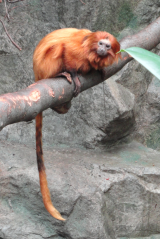
African elephant (Loxodonta):
They are found in Africa and are the largest walking animals on earth. This genus is comprised of two elephant species: African bush elephant (L. africana) and African forest elephant (L. cyclotis).
Asian elephant (Elephas maximus):
A species found in Tamil Nadu, India. They have been classified as endangered species by International Union for the Conservation of Nature (IUCN).
Pemba flying fox:
They belong to the species of bats, found on the Island of Pemba in Tanzania. They belong to the family Pteropodidae. These bats have been listed among vulnerable species by IUCN.
Chesapeake blue crab:
They are found in waters of Atlantic Ocean and Gulf of Mexico. They are known as Callinectes sapidus, the blue crab or Atlantic blue crab.

Mountain gorillas (Gorilla beringei):
World Wildlife Fund has kept Gorillas as flagship species over 50 years. There are four sub-species of Gorillas known:
- Western Lowland gorillas (G. gorilla gorilla): they are found in the lowland forests of central and west Africa. They are the smallest but abundant of all the subspecies.
- Cross River Gorillas (G. gorilla diebli): they have been listed as critically endangered species by IUCN. They are found in northern/western parts of Africa.
- Eastern Lowland gorillas (G. beringei graueri): they are the largest of all gorilla subspecies and are also called The Grauer’s gorilla. They are found in the eastern parts of Democratic Republic of Congo. They are third adversely endangered among their subspecies.
- Mountain gorilla (G. beringei beringei): They are found in the regions of Virunga Mountains in Rwanda and Uganda. They are second most endangered among four subspecies.
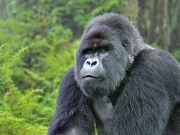
Bonobo (Pan paniscus):
They are also known as pygmy chimpanzee. They belong to the Mammalia family and are considered to be an endangered ape. They are found in the Democratic Republic of the Congo.
Chimpanzee (Pan troglodytes):
It is a species of great ape found in the forests of Tropical Africa. They are listed as an endangered species in the IUCN red list.
White rhinoceros (Ceratotherium simum):
They are also known as square-lipped rhinoceros. They are further divided into two subspecies:
- The southern white rhinoceros: It is most common and widespread in south Africa.
- Northern white rhinoceros: it is a rare subspecies of rhino found in east and central regions of Sahara in South Africa.
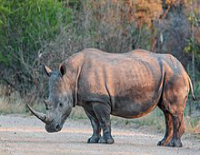
Black rhinoceros (Diceros bicornis):
They are also called hook-lipped rhinoceros found in eastern and southern Africa. Their overall species have been listed among critically endangered.
Polar bear (Ursus maritimus):
They have been listed into endangered species by US Government. They are found in Arctic ecosystems. They are also an example of keystone species.
Sea turtles (Chelonioidea):
They are also called marine turtles. There are seven existing species of sea turtles which are found in US waters, that includes;
- Australian flatback sea turtle (Natator depressus): They are found on the sandy beaches and shallow waters in Australia. They come under threatened species and has been named in the red list by IUCN.
- Green sea turtle (Chelonia mydas): It belongs to the family of large sea turtles. They are found throughout tropical and subtropical seas around the world and also in India Ocean.
- Hawksbill sea turtle (Eretmochelys imbricata): These are listed as critically endangered species. They are widely distributed in tropical reefs of Indian, Pacific and Atlantic Oceans.
- Leatherback sea turtle (Dermochelys coriacea): They are often called as lute turtle or leathery turtle. These are the largest among all turtles. They are found in all tropical and subtropical oceans.
- Loggerhead sea turtle (Caretta caretta): They widely distributed in Atlantic, pacific, Indian Oceans and Mediterranean Sea.
- Kemp’s ridley sea turtle (Lepidochelys kempii): they are the rarest and endangered species among sea turtles.
- Olive ridley sea turtle (Lepidochelys olivacea): they are found most abundantly than any other in the world. They are found in warm tropical waters, Pacific and Indian oceans.
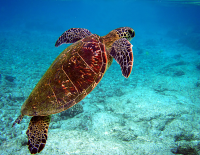
Manatees:
They are the marine mammals that belongs to the Trichechidae family and Trichechus genus. They are also known as Sea cows. There are three species of Trichechidae or Manatees:
- Amazonian manatee (Trichechus inunguis): it is found in Amazon basin in Brazil, Peru, Bolivia, Colombia, Venezuela and Ecuador.
- West Indian manatee (Trichechus manatus): they are found in Florida, Texas, and Massachusetts. It has been listed in Endangered species. Based on their genetic and morphological studies they have been further subdivided into two subspecies; Florida manatee (T. m. latirostris) and Caribbean manatee (T. m. manatus).
- West African manatee (Trichechus senegalensis): It is also known as African manatee found in western regions of Africa.
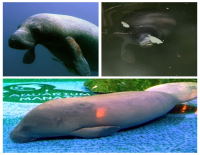
Bald eagle (Haliaeetus leucocephalus):
They are found near large open water bodies, in North America, Alaska, Canada and northern Mexica.
European Otter (Lutra lutra):
It is also known as Eurasian otter, common otter and Old-World otter. They are widely distributed and found in waterways and costs of Europe, northern Africa and Asia.
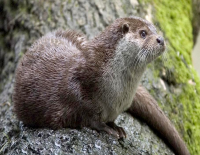
Monkey puzzle tree (Araucaria Araucana):
This tree is known worldwide and is a flagship species and a national tree of Chile. It is listed under endangered species.
Bornean Ironwood (Eusideroxylon zwageri):
This tree comes under cultural flagship and is used for medicinal purposes and rituals by the people of Dayak tribe.
Malagasy Baobabs (Adansonia):
These are called upside down trees with their swollen trunks and crown like small branches. It comes under ecological flagship and is found in Madagascar where it symbolizes the unique diversity of the Island.
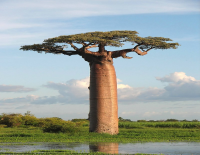
Objective of Flagship species:
- The central objective of flagship species is to create awareness among people and to channelize the information about the biodiversity and the necessity for its conservation.
- It helps in highlighting the unique species of animals and plants and make them iconic and popular throughout the world.
- Secondary objective is to implement the strategies and ways to conserve various species throughout the world.
Limitations:
- Marketing issues, conveying message to the audience through campaigns, multimedia.
- Obtaining funding for conservation projects and to protect the endangered species.
Please click to learn on Exotic species examples.
- Meiosis Stages Unveiled: A Deep Dive into Cellular Division
- Mitosis Stages: A Comprehensive Guide for Understanding Cell Division
- Meiosis: Unraveling the Intricacies of Cellular Division
- Mitosis Explained: A Comprehensive Guide to Cell Division
- Mitosis vs Meiosis: Unveiling the Mystery of Cell Division
- Calvin Cycle: Unraveling the Secrets of Plant Photosynthesis
Also Read:
- Do humans have animal cells
- Monoecious plants examples
- Monophyletic group example
- Nucleic acid
- Monera examples
- Obligate parasite
- Is catalase an enzyme
- Meiosis stages
- Does mitochondria have circular dna
- Is cell wall made of cellulose
Hey! I am Sneha Sah, I have completed post graduation in Biotechnology. Science has always been fascinating to me and writing is my passion. As an academic writer my aim is to make Science easy and simple to learn and read.